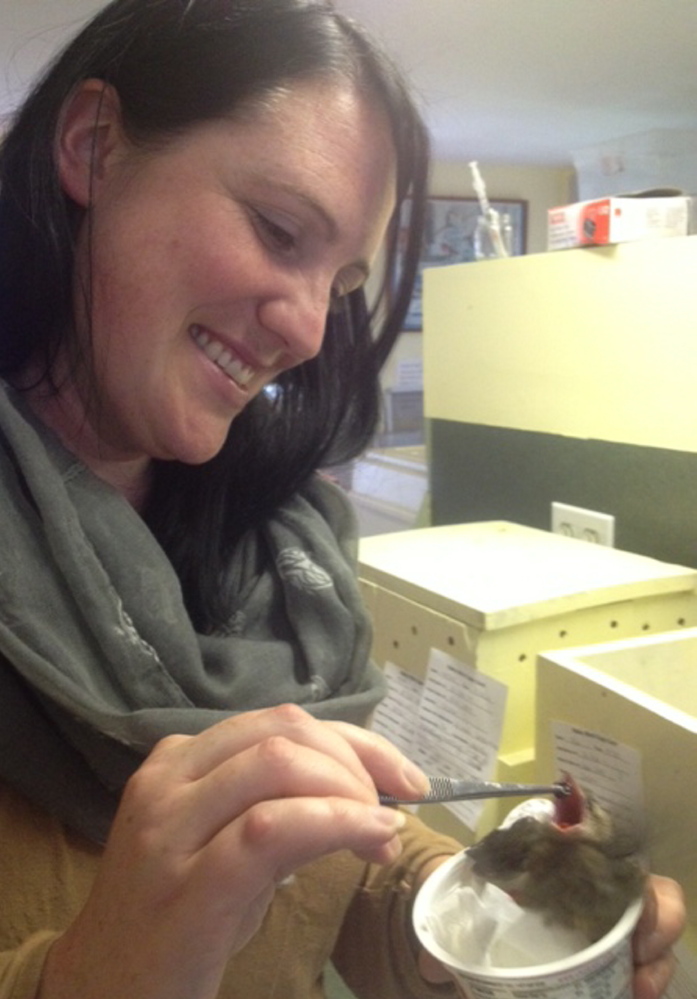YORK — As Kristen Lamb fed a 2-week-old cedar waxwing, admiring the tiny bird’s mask and hair crest as she did, a broad smile crossed her face. Lamb became director of the Center for Wildlife in 2012, a decade after she started volunteering there. Over the years, as Lamb advanced at the center, the wildlife rehabilitation facility grew in step. Lamb said her devotion to the center remains rooted in a deep love of wildlife.
Now as the 28-year-old center embarks on its first capital campaign to allow it to move from a rented campus to a home of its own, Lamb said its continued growth is assured in a state teeming with wildlife.
How long have you been at the Center for Wildlife?
I came to the center in 2003. I went to school at Bentley for business but it was not a good fit so I transfered to the University of New Hampshire for wildlife ecology. I came here as a college volunteer. I stayed on a year after I graduated to work as a supervisor of volunteers. Then I went to Plum Island in Massachusetts to work as a park naturalist for two years. I worked with the U.S. Fish and Wildlife Service on piping plover studies. Then I came back here in 2007 as the education outreach director, although the entire time, even when I was at Plum Island, I worked part-time here. Eventually my position grew into education director, outreach and marketing. I also was doing the budget. It feels good to be part of a place I love.
When did you become director?
Two years ago. I didn’t know when I went to Plum Island I’d come back (full-time). But the pull here was so strong. It’s such important work. A lot of people I graduated with at UNH went to New Hampshire Fish and Game or Inland Fisheries and Wildlife. I feel those roles are important. But at Plum Island I learned the challenges faced by wildlife and I feel there is so much good work to be done here with rehabilitating animals every day. When people find an injured animal and they ask what to do, there is so much that happens. They think someone else does this and they call and ask who to contact. But we tell them, ‘You’re the one who has to act.’
What percentage of the people who rescue wild animals have done that before?
(Laughs) We do have some repeat rescuers but it’s probably 10 percent. The other 90 percent say they called a vet, or animal control officers, or IFW. Every day we’re explaining to people there is no branch of government, no wildlife wardens who save wildlife. We explain that to help that animal it’s going to have to be them. We always give the person who brings in an animal first dibs on releasing it.
What has changed since you became director in 2012?
We’ve grown the clinic, the facility to care for the animals. That’s grown as the demand for service spiked. In 2005 we did 50 to 60 education programs a year and saw 1,200 wild animals a year. Now we do 225 educational programs a year and care for 1,500 to 1,700 animals. The two-fold mission is important. If we aren’t connecting people to wildlife, then the future of wildlife is unknown. The clinic and the education piece share equal parts of our mission. We get 12,000 calls a year concerning injured wildlife. We have statistics that show how certain species tend to get into trouble. It feels good. We feel sad when we need to euthanize an animal, but we tell that story about why it died. So that life is not lost. That animal did not just pass away. Its story will be told.
How many animals do you release?
Across the board we have a 50 percent success rate. A lot depends on the injury when it’s brought in. Since we began in 1986 we have admitted 28,000 animals. That’s 14,000 animals released back into the wild.
What else has changed here?
We never had an area that was separate from the clinic that was open to the public. People who were dropping off animals felt they were missing out. There was this amazing curiosity but they couldn’t come visit. In the last four years with (several grants) we built a pavilion where we have on-sight programs. People can do a self-guided tour. There used to be a sign that said the center was not open to the public. That sign is now gone and we offer tours from May to September on Tuesdays, and we have programs. We have trained docents who lead tours every other Saturday. We are working with an Eagle Scout on building a docent station and gift shop.
Also, when we started we had college interns from local universities. Now we have them from around the country. Students come from schools in Utah, Colorado, Wisconsin, Kentucky.
Copy the Story LinkSend questions/comments to the editors.




Success. Please wait for the page to reload. If the page does not reload within 5 seconds, please refresh the page.
Enter your email and password to access comments.
Hi, to comment on stories you must . This profile is in addition to your subscription and website login.
Already have a commenting profile? .
Invalid username/password.
Please check your email to confirm and complete your registration.
Only subscribers are eligible to post comments. Please subscribe or login first for digital access. Here’s why.
Use the form below to reset your password. When you've submitted your account email, we will send an email with a reset code.